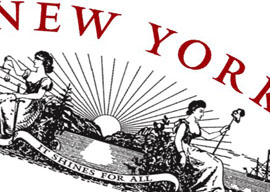
September 26, 2010

The end of this month “ September 30, 2010, to be exact “ will mark the second anniversary of the death of the best conservative newspaper in America, and one of the best newspapers in the country, period. It was called the New York Sun (2002-08) and was edited by Seth Lipsky, a man who, as well as possessing an eye for news, also had an appreciation for beauty. Visually ravishing, on a good day the Sun could make almost every other paper around look like a middle aged frump standing next to Maria Sharapova.
The motto on the Sun‘s masthead was, “It Shines for All.” Unfortunately, this was never quite the case. When it came to this particular celestial body, most New York Dems acted like vampires in a midday heat wave. They stayed in, they drew the blinds, they locked themselves in coffins, and hid from the shoestring conservative challenger to the almighty New York Times as if it were a cross borne by a Pope chewing on garlic.
The original version of the Sun was published from 1833-1950, when it was merged with the New York World-Telegram before finally exiting history in 1966. When Lipsky revived the Sun on April 16, 2002, he attempted something almost suicidally bold: To create a stylish up-market paper that would have the best arts section in New York tied to editorials that were pro-Bush, pro-Israel, and against most of the Democratic agenda. The cognitive dissonance caused by the combination of a conservative paper with voluptuously highbrow arts pages and Euro-friendly sports pages left smart New York liberals in a dither. If they could have channeled T.S. Eliot, their sentiments might have read:
O O O O that New York Sun
It’s so elegant
So intelligent
But so dreadfully Republican!
When I first caught sight of the Sun on a newsstand, it was its look, retro but cool, that drew me in. Soon I started reading it, though doing so in downtown New York, especially as the 2004 Bush-Kerry election approached, was a bit like belonging to a cult without knowing if there were any other members. Opening it in a café felt like a political statement. It’s not as if there were no other conservative papers in the city “ the New York Post certainly made a lot of noise—but reading the Sun meant something specific. It was an act of rebellion against the Times“ eternal monopolization of the city’s intellectual class.
This did not turn out to be something the intellectual class was keen to promote. Evidently, they wanted to be monopolized. Even if people moaned about it, the Times was a badge of belonging, as much a symbol of the city as Broadway or the Empire State Building. The Sun evoked a murkier possibility, namely membership in a silent minority. No one could be sure whether you belonged to it for political or cultural reasons or both.
The Sun was read and enjoyed by most of the elites in New York and Washington. For the most part, however, they were careful not to commit their enthusiasm to print until it was safely in its death throes. Instead, a steady drip of cheap-shots, sneers, and quibbles were meted out from the likes of Gawker, which called it “a vile rag”; Slate, which accused it of Fascism; and the Columbia Journalism Review, which, given its purported job description, particularly disgraced itself. There were exceptions. In 2007, five years after the Sun‘s launch, the Nation’s Scott Sherman finally wrote a semi-credible account of the paper: “All in all, a fabulous read for culture, and a tendentious (though not uninteresting) one for politics,” being the key sentence. An intriguing portrait of Lipsky aside, however, most of the article was taken up by the tired subject of the paper’s stance on Israel and the U.N.—a constant source of controversy, not least among Jews themselves. Vanity Fair‘s James Wolcott also praised the arts and sports pages on his blog, while making plain his dislike for the rest of it.